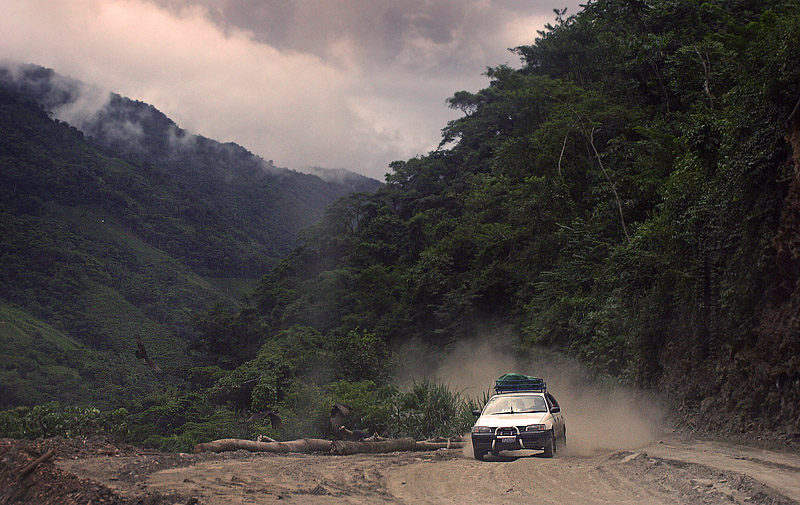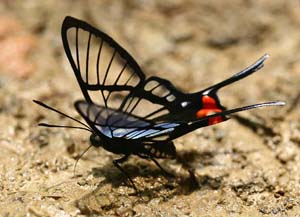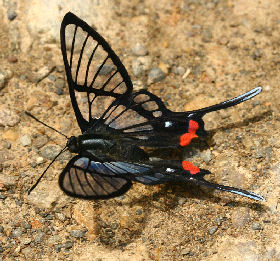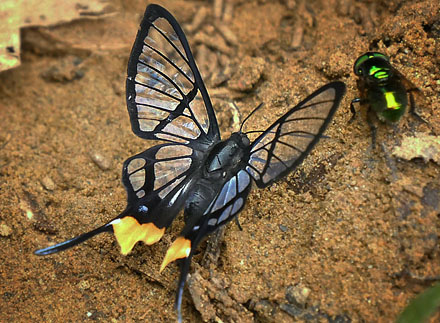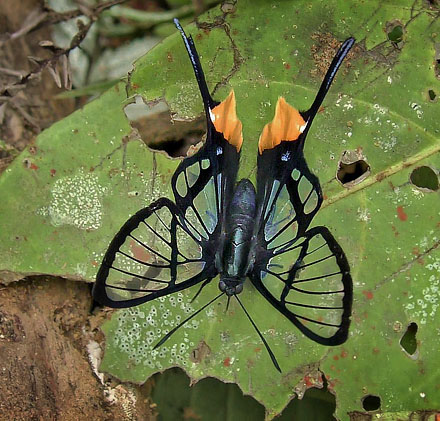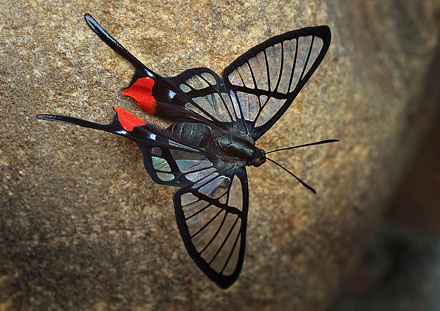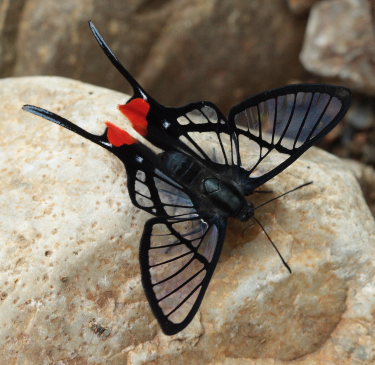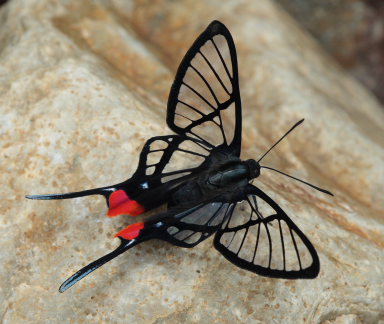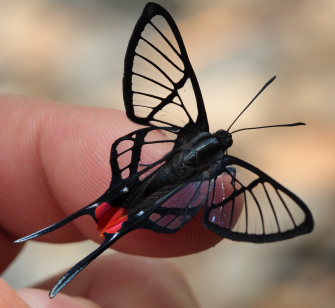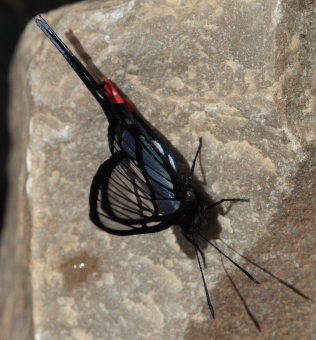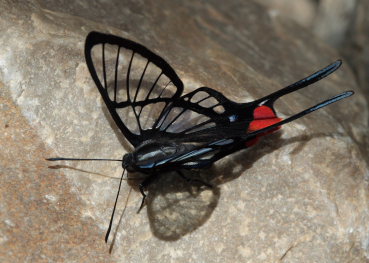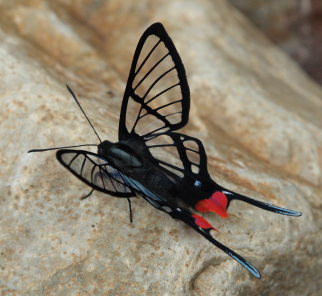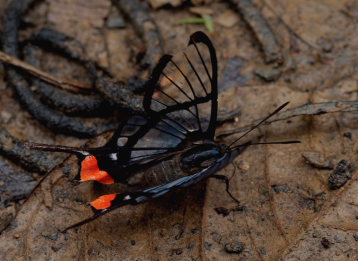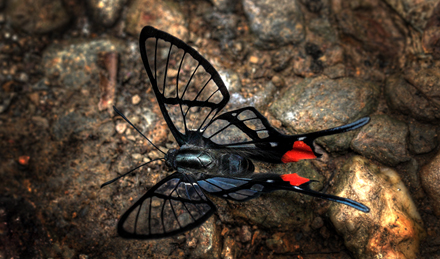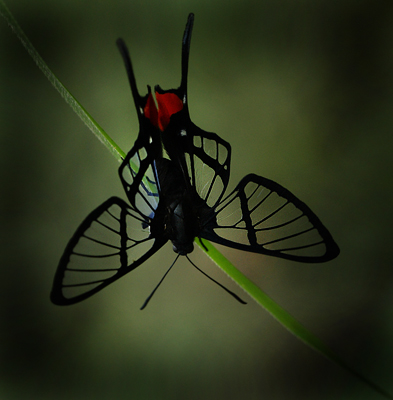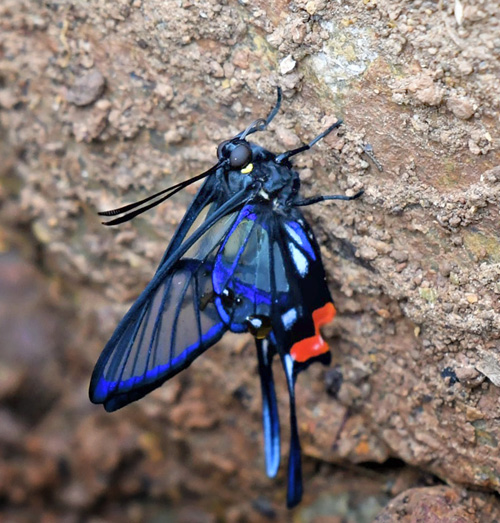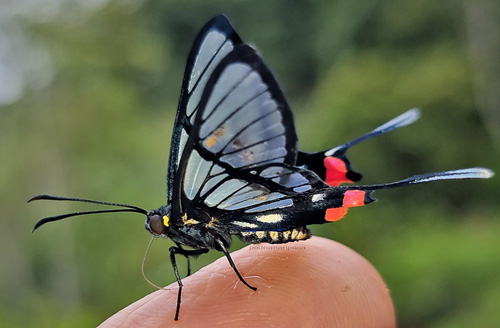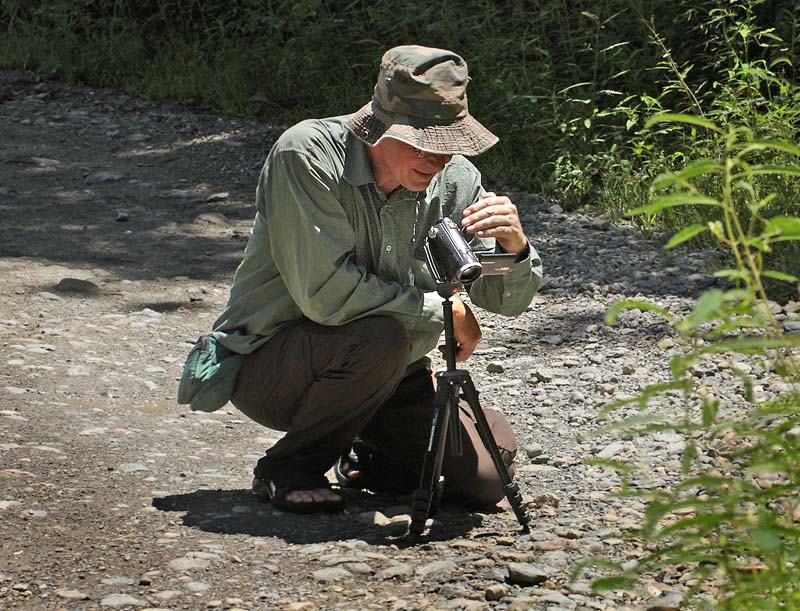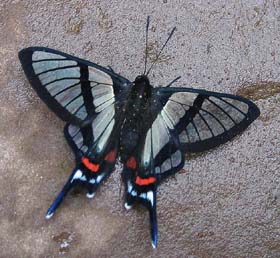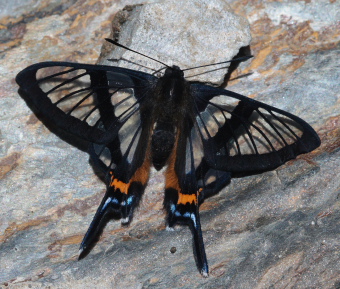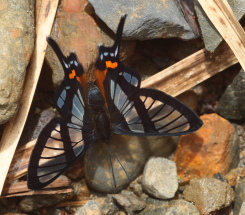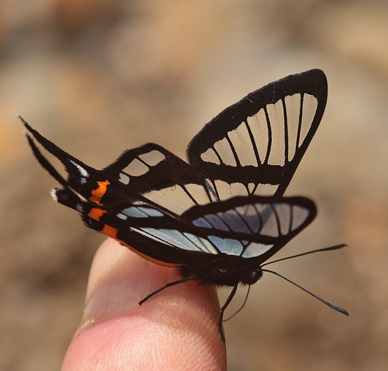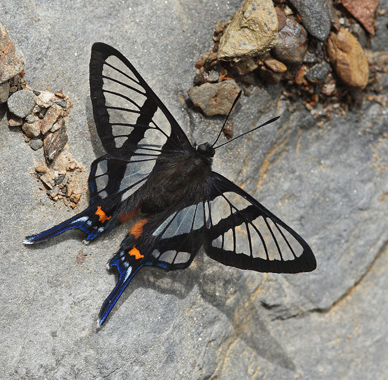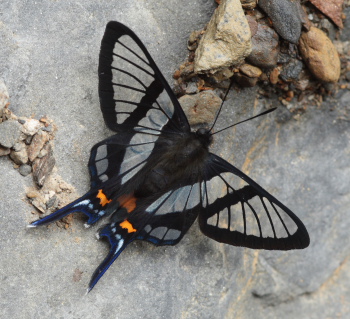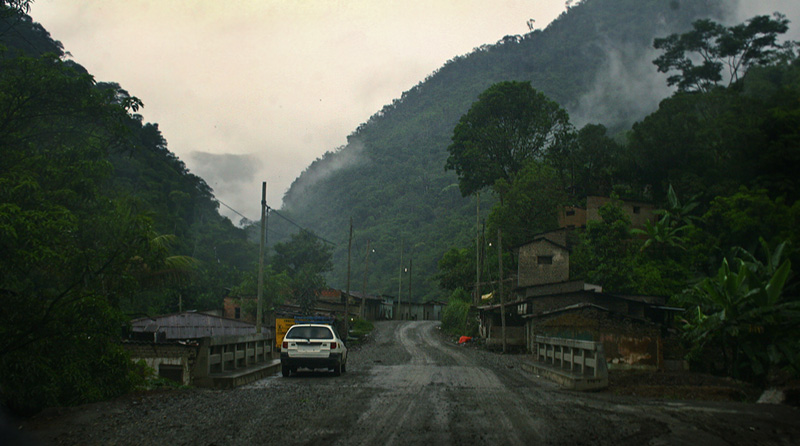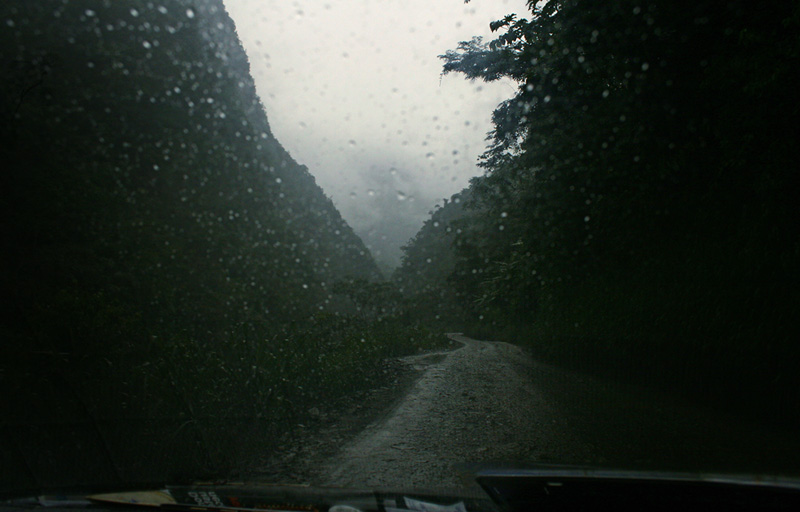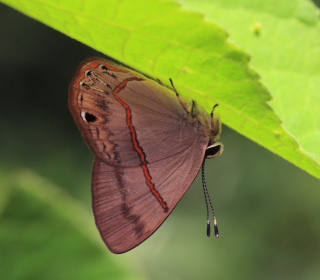Bee Butterflies
Chorinea, Riodinidae
first update d. 3 october 2024
last update d. 3 october 2024
_____________________
The
world's most dangerous highway between La Paz and the
Amazon on the Rio Coroico,
where vultures
waiting for a traffic accident. Yungas, Bolivia d. 28 january
2007. Photographer; Lars Andersen
_____________________
Bee
Butterflies Family Metalvinger, Riodinidae Grote, 1895 (146 genera, 1532 species) _________________ Familien
inkluderer små til mellemstore arter, fra 12 til
60 mm i vingefang, Arter forekommer
på en række forskellige habitater, men har et
unikt udbredelse i de tropiske regnskove i
Sydamerika især på Andesbjergenes østlige
bjergskråninger op til 2300 meters højde. _________________ Bee
Butterflies Genus: Chorinea Gray, 1832. Genus 8 species Chorinea
amazon
(Saunders, 1859) iN _________________ Reference: Journal of the
Lepidopterists’ Society Coloration
and Structure
of the Wings of Chorinea sylphina (Bates, 1868). Chorinea |
_____________________
Amazon Angel, Chorinea amazon (Sauders, 1859) Photographer; Lars Andersen
Amazon Angel, Chorinea amazon & Fabricius Angel, Chorinea octauius
| The genus Chorinea comprises 8 species in tribe Riodinini in Riodinidae family. Distribution: who all are
found in tropical America from Guatemala to
Panama in central America, continued in southern
America along the Andes mountains in countries
such as Colombia, Venezuela, Ecuador, Peru and
Bolivia. And in the Amazonas from Brazil, Guyana,
Paraguay and Misiones in northern Argentina. They look very much like miniature swallowtails, with transparent wings marked with black veins. In all species the thorax is virtually devoid of "hair" and the palpi are extremely short. All Chorinea species have the same basic wing pattern but vary in the configuration and extent of the red markings on the hindwings. Chorinea species mimics the bee's flight so any predators fail to catch them. Therefore they are also called bee-butterflies. _____________________ Slægten Chorinea som består af 8 arter i tribe Riodinini, Riodinidae familien som alle sammen findes i tropisk America fra Guatemala til Panama i Mellemamerika, videre i Sydamerika langs Andesbjergene i lande som Colombia, Venezuela, Ecuador, Peru & Bolivia. Og i Amazonas fra Brasilien, Fransk Guyana, Paraguay og Misiones i det nordlige Argentina. De ligner små svalehaler med gennemsigtige vinger med sorte ribber & bånd med blå haler. På alle arter er thorax/ brystkassen næsten blottet for "hår" og palper/palpi er ekstrem korte. Alle Chorinea arter har samme grundlæggende ribbe mønster, som varierer i form og omfanget af de røde pletter på bagvinge analhjørne. Chorinea arter efterligner biers flugt så eventuelle prædatore undlader at fange dem. Derfor kaldes de også Bisommerfugle. |
_____________________
Amazon Angel, Chorinea amazon (Sauders, 1859) Photographer; Lars Andersen
| Amazon
Angel, Chorinea
amazon (Sauders,
1859) Distribution:
Amazonas Bisommerfugl, Chorinea amazon (Sauders, 1859) Udbredelse: |
| Fabricius Angel, Chorinea octauius (Fabricius, 1787) with yellow spot on rearwing. |
| Garrapatuni, Caranavi, Yungas, Bolivia January 15, 2016. Photographer; Peter Møllmann |
Amazon Angel, Chorinea amazon (Sauders, 1859). Photographer; Lars Andersen
| Amazon Angel, Chorinea amazon (Sauders, 1859) with yellow spot on rearwing. |
| Garrapatuni, Caranavi, Yungas, Bolivia January 15, 2016. Photographer; Peter Møllmann |
_____________________
Fabricius Angel, Chorinea octauius (Fabricius, 1787) Photographer; Lars Andersen
| Fabricius
Angel, Chorinea
octauius
(Fabricius, 1787) syn. C. faunus Habitats: Behaviour : Life cycle: Distribution: _____________________ Fabricius Angel, Chorinea octauius (Fabricius, 1787) Photographer; Lars Andersen Fabricius Bisommerfugl, Chorinea octauius (Fabricius, 1787) syn. C. faunus. Levested: Adfærd: Livscyklus: Udbredelse: |
| Fabricius
Angel, Chorinea octauius with yellow marks behind
eyes and on thorax. Caranavi Highlands 1200m., Bolivia December 18, 2021. Photographer; Nikolaj Kleissl |
Fabricius
Angel, Chorinea octauius with yellow marks behind
eyes and on thorax I have not seen before? Caranavi Highlands 1200m., Bolivia December 18, 2021. Photographer; Peter Møllmann |
_____________________
Two Chorinea species from Yungas-Bolivia
d. 1 february 2009
Two Chorinea species from Yungas-Bolivia by Peter Møllmann on Youtube
| Two
species of the Chorinea metalmarks, Chorinea
octauius and Chorinea
sylphina. The last one very rarely seen in the highlands. |
_____________________
Peter Møllmann filmming butterflies. Yolosa, elev. 1200 m. Yungas, Bolivia 18th January 2012. Photographer: Lars Andersen
_____________________
Sylphina Angel, Chorinea sylphina
Sylphina Angel, Chorinea sylphina (H. Bates, 1868). Oxapampa, elev 1600 m. Peru d. 4 december 2006. Photographer; Moriaan Zwart
Sylphina Angel, Chorinea sylphina (H. Bates, 1868) Photographer; Lars Andersen
| Sylphina
Angel, Chorinea
sylphina (H.
Bates, 1868) Habitats: _____________________ Andes Bisommerfugl, Chorinea sylphina (H. Bates, 1868) Habitats: Udbredelse: |
_____________________
_____________________
The world's most dangerous road
| The world's most dangerous highway between La Paz and the Amazon on the Rio Coroico where it has started to rain, |
| Yungas, Bolivia d. 28 januar 2007. Photographer; Lars Andersen |
| Verdens farligste hovedvej imellem La Paz og Amazonas ved Rio Coroico hvor det er begyndt at regne, |
| Yungas, Bolivia d. 28 januar 2007. Fotograf; Lars Andersen |
_____________________
Euselasiinae & Riodininae
sitio 55
_____________________
Mariposas de Bolivia
Enero 2009
por Peter Møllmann y Lars Andersen
_____________________
